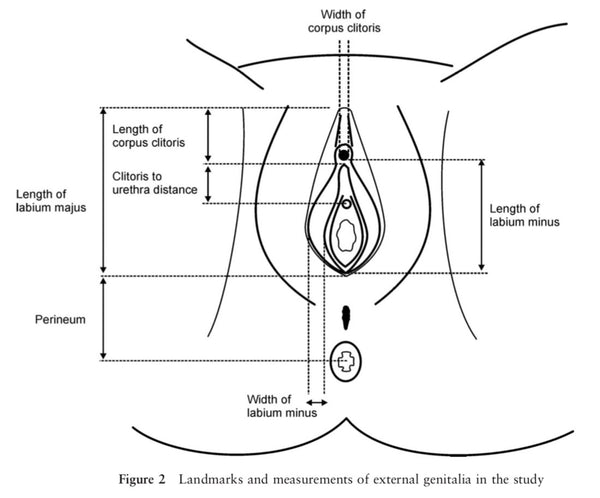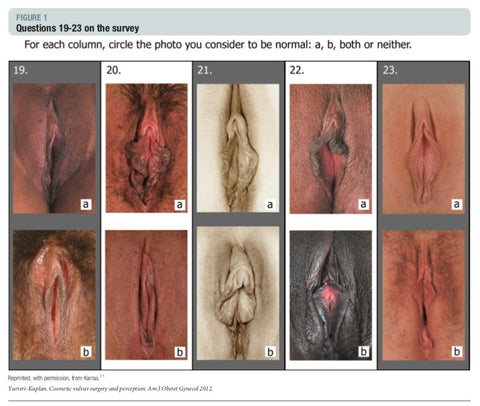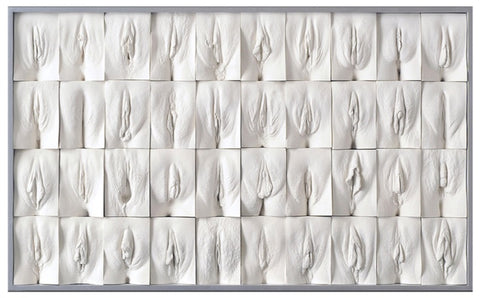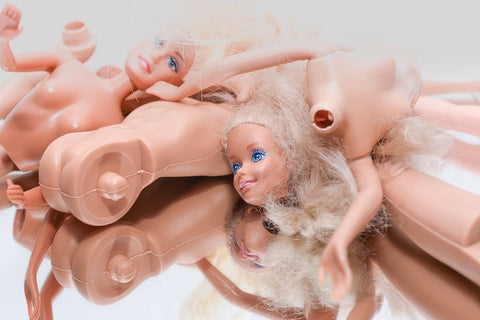
"I think that people just expect it to be like smooth, and, nothing sticking out." (Participant 18, 21 years) [5]
By James Wang and Liz Klinger, Co-founders of Lioness
Between pornography and media portrayals of scantily-clad women, there is a stereotype of what a vulva should look like. Hairless, neat, tiny, and nearly invisible.
Not coincidentally, with the rise of this conception of normal, labiaplasty in the US has increased by whopping 217.3% between 2012 and 2017, according to the American Society for Aesthetic Plastic Survey (ASAPS)—even those these procedures cost nearly $3,000.
Of course, that "normal" vulva isn't actually so normal.
Just look at the vulva diagram at the top of this article—there are a LOT of expected ways individuals are going to differ. [2]
In this article, we'll talk about how we got here and how wide the normal variation between vulvas can really be.
What do people think is a normal vulva / "vagina"?
At least in most developed "western" countries (North America, Europe, etc.), ideal vulvas are portrayed hairless, with a small clitoris, nearly nonexistent labia, and a small vagina introitus. The last item means there isn't a visible opening to the vagina from the vulva. [9]
The below shows a typical "most normal" and "ideal" vulva chosen by most participants in one study from Australia (they're two different questions—with the same answer). [5]


Changing media portrayals can influence what we think is "normal"
In a way, it's not that surprising that we have this societal conception. After all, it's what we constantly see in the media.
One interesting study looked at photographs of cis-gender women either naked or in tight clothing—from glossy women's magazines, mind you, not porn. In 86% of all photographs where the pubic area was visible, the women were almost "Barbie doll" smooth, either due to models being selected for that "feature" or from post-production editing. [3]
Another set of researchers looked at Playboy Magazine centerfold models. Over the years, when visible, the models' pubic areas lost more and more hair. The "Brazilian" with no pubic hair at all only arose in the 2000s. [7]


Of course, as with most fantasized ideals in women's bodies, this specific image of the vulva has proliferated in pornography. This, in turn, influences a lot of adolescents (and frankly, many adults) that form their ideas of what's sexually normal from this type of media.
Taboos pervade even in medicine—and hold everyone back
Unfortunately, the problem runs even deeper. Even medical professionals often don't appreciate the level of normal variation in women's genitals. Most medical textbooks give only idealized diagrams of the vulva, with no descriptions of how variable parts of the vulva can be.
As Dr. Naomi S. Crouch aptly wrote in the book Female Genital Cosmetic Surgery: Solution to What Problem?:
Out of 59 popular medical textbooks, only one gave measurements and range of variation for both the labia majora and minora. [1] This is obviously pretty bad since even medical practitioners have trouble informing their patients about what is normal or not.
Finally, the researchers and practitioners who ARE interested in learning more about the nuances of genital anatomy face an uphill battle getting funding and resources, or even just being taken seriously.
One poignant example is Dr. O'Connell's experience. She's known as the first person to map the full anatomy and nerve pathways of the clitoris. As noted in this Guardian interview:
[Dr. O'Connell] recalls a conversation at an awards night, in which one of her students won a prize for a study of the suspensory ligaments that hold the clitoris in place.
“The very senior figure directly across from me thought that her work was – and I was her supervisor, I don’t think he knew that – he thought it was voyeurism,” she says.
“She’s doing scientific research about anatomy, and that, in his world … ”
She pauses. “What happened to him, that he sees a young woman doing a project like that and thinks of it with a sexual innuendo? That is just, to me, unfathomably unrelated to the way my brain works.”[11]
The question remains, if a large number of colleagues in the medical and scientific spaces are uncomfortable describing the anatomy, function, and purpose of the vulva, the clitoris, the orgasm, and everything related — and some of these people are the gatekeepers of published editorials, study approvals, and funding — how will we really get to learn about the anatomy and health of 50% of the world's population? This frustration is part of our motivation of starting the Lioness Sex Research Platform, which is an ongoing effort to make conducting studies in this subject easier.
So what does a normal vulva actually look like?
The fact that our "normal" vulva conception is so recent should tell you something. Even today, other countries have different expectations on what vulvas should look like. In Japan, "butterfly"-shaped vulvas are preferred, while certain African countries deliberately stretch the labia at a young age for aesthetic reasons. [9]
"Normal" vulva shapes have changed drastically across time and cultures—which calls into question how right our conception of normal really is.
The reality is that normal vulvas can look very, very different from one another.
All of these are normal
The pictures below are from a set of survey questions asking participants what vulvas they consider normal. [9] The pictures themselves were drawn from a photo project called Petals.

The "trick answer" is that these are all well within normal variation. In fact, true variation is even wider, both in how wide the labia "lips" (majora and minora) can get and how much pubic hair there can be.
Another project from the UK—lacking pubic hair due to the logistics of plaster casting but illustrative of labial variation—called Wall of Vagina made plaster casts of different women’s vulvas to, again, show how variable, and normal, these shapes all are.

And on Instagram, there is a popular account on Instagram called The Vulva Gallery (the.vulva.gallery), where artist Hilde Atalanta receives user submitted pictures of vulvas and they illustrate the vast diversity of bodies out there — from hair, hairless, one or both lips protruding, bumps, and more.
Variation is normal
Whatever your vulva looks like, it's almost certainly normal and ok. It may sound kind of trite, but that understanding is pretty important.
Studies have shown that poor genital self-image can cause issues with sex and arousal in women, and also that seeing realistic pictures significantly (and permanently) boost self-confidence of women regarding their own bodies. [4]
It's not just about aesthetics
Playing devil's advocate for a moment, one might argue that the stratospheric increase in labiaplasty is just because women want it aesthetically. Maybe it's for the wrong reasons, but they just like how it looks, not because they think their own vulvas aren't "normal" or good enough.
While there are medical conditions where labiaplasty is recommended (which exist but are relatively rare), it's much more likely that most labiaplasties are actually because people don't appreciate what normal is.

Barbie dolls are not the standard of normal—in pretty much any dimension.
Why? Well, in cases where women are shown the level of variation that is both possible and normal in vulvas, the level of interest in labiaplasty significantly decreases. In certain studies, interest goes from nearly 30% to single digits. [4, 8] That's despite the fact that many of them intellectually know, and respond, that their own vulvas are not abnormal.
The fact that there's such a drastic change from just seeing diversity in vulvas suggests that subconsciously they don't actually think their vulvas are normal or good enough on their own—even though they are.
Even the vast majority of men, who are probably the audience most affected by pornography, don't think their partners need to change their genitals. They also don't think variations in appearance affect their pleasure at all. [6]
A case when it's more than aesthetics: Gender identity and genitals
Although many of these studies have primarily focused on cis-women, poor genital self-image can also affect trans and nonbinary individuals. In addition to being influenced by media portrayals, for some individuals (though not all) there may experience a disconnect between their gender identity and their genitals.
In some of those cases, genital gender-affirming surgery may be extremely helpful with addressing that disconnect. As one study points out: "A subset of patients [who undergo genital gender-affirming surgery] may describe unambiguously negative feelings toward this part of their bodies, and many report that their genitals are the most, or among the most, significant source of gender dysphoria (Coleman. Int J Transgenderism. 13:165–232, 2012)." In some of these cases, genital gender affirmation surgery can address gender dysphoria. [12]
We're not normal — but that's very normal (and beautiful).
People are free to do what they do, and like what they like... but it's important to have enough education around what's normal—and real—and be able to make informed decisions.
In this case, the range of normality in genitals is far greater than most people appreciate. In fact, even beyond just "normal", the range of beauty is a far more expansive concept than what we see in media and pornography.
Almost everything in our sexual health is extraordinarily individual and remarkable, from anatomy, appearance, to what we enjoy, and more. That's why self-appreciation and self-exploration are so important. We're all very unique. And, while in a way that makes us all abnormal... it, at the same time, makes us completely normal in our uniqueness.
===
Want to get started self-exploring? We make a vibrator that specifically helps with that. Learn more about The Lioness.
Unlock the secret to better orgasms withLioness, the world’s most advanced vibrator.
Using built-in sensors and an intuitive mobile app, Lioness lets you visualize your arousal and orgasms. Simply use Lioness like any other vibrator, then review the results on your phone. Soon, you’ll begin to understand how your body responds and make every climax more enjoyable.
Click hereto learn more.
===========
References
[1] Andrikopoulou, M., Michala, L., Creighton, S. M., & Liao, L.-M. (2013). The normal vulva in medical textbooks. Journal of Obstetrics and Gynaecology, 33(7), 648–650. http://doi.org/10.3109/01443615.2013.807782
[2] Basaran, M., Kosif, R., Bayar, U., & Civelek, B. (2009). Characteristics of external genitalia in pre- and postmenopausal women. Climacteric, 11(5), 416–421. http://doi.org/10.1080/13697130802366670
[3] Bramwell, R. (2002). Invisible labia: The representation of female external genitals in women's magazines. Sexual and Relationship Therapy, 17(2), 187–190. http://doi.org/10.1080/14681990220121293
[4] Ellen, L., K, M. D., Sara, H., Nóinín, S., & van Lunsen Rik H W. (2016). Young women’s genital self-image and effects of exposure to pictures of natural vulvas. Journal of Psychosomatic Obstetrics 8 Gynecology, 0(0), 1–8. http://doi.org/10.1080/0167482X.2016.1233172
[5] Howarth, C., Hayes, J., Simonis, M., & Temple-Smith, M. (2016). “Everything”s neatly tucked away’: young women’s views on desirable vulval anatomy. Culture, Health & Sexuality, 18(12), 1363–1378. http://doi.org/10.1080/13691058.2016.1184315
[6] Mazloomdoost, D., Crisp, C. C., Westermann, L. B., Benbouajili, J. M., Kleeman, S. D., & Pauls, R. N. (2015). Survey of male perceptions regarding the vulva. American Journal of Obstetrics and Gynecology, 213(5), 731.e1–731.e9. http://doi.org/10.1016/j.ajog.2015.05.063
[7] Schick, V. R., Rima, B. N., & Calabrese, S. K. (2011). E vulvalution: The Portrayal of Women's External Genitalia and Physique across Time and the Current Barbie Doll Ideals. Journal of Sex Research, 48(1), 74–81. http://doi.org/10.1080/00224490903308404
[8] Truong, C., Amaya, S., & Yazdany, T. (2017). Womenʼs Perception of Their Vulvar Appearance in a Predominantly Low-Income, Minority Population. Female Pelvic Medicine & Reconstructive Surgery, 23(6), 417–419. http://doi.org/10.1097/spv.0000000000000442
[9] Yurteri-Kaplan, L. A., Antosh, D. D., Sokol, A. I., Park, A. J., Gutman, R. E., Kingsberg, S. A., & Iglesia, C. B. (2012). Interest in cosmetic vulvar surgery and perception of vulvar appearance. The American Journal of Obstetrics & Gynecology, 207(5), 428.e1–428.e7. http://doi.org/10.1016/j.ajog.2012.06.056
[10] Creighton, S. M., Liao, L. (2019). Female genital cosmetic surgery: Solution to what problem? Cambridge: Cambridge University Press.
[11] Wahlquist, C. (2020, October 31). The sole function of the clitoris is female orgasm. Is that why it's ignored by medical science? Retrieved November 03, 2020, from https://www.theguardian.com/lifeandstyle/2020/nov/01/the-sole-function-of-the-clitoris-is-female-orgasm-is-that-why-its-ignored-by-medical-science
[12] Garcia M.M. (2020) Strategies to Optimize Sexual Function with Feminizing and Masculinizing Genital Gender-Affirming Surgery. In: Schechter L. (eds) Gender Confirmation Surgery. Springer, Cham. https://doi.org/10.1007/978-3-030-29093-1_21




